BLOG: Complex periprosthetic tibia fracture
This case involves a 64-year-old diabetic woman who had a left total knee placed in 2001 by an outside surgeon.
The patient’s postoperative course was unremarkable and had no complaints until 1 month prior to presentation to OrthoCarolina’s Hip and Knee Center. At that point in time, the patient developed recurrent pain and swelling of her left total knee without any history of trauma. These symptoms continued for 1 month before presenting to her outside surgeon for evaluation.

Infection workup by her outside surgeon showed a normal erythrocyte sedimentation rate and C-reactive protein and a negative aspirate. One month later, the patient was standing in her kitchen when her knee “buckled under her,” causing her to fall directly onto that knee. Radiographs (Figure 1) and CT scan (Figure 2) obtained at an outside emergency room showed a complex periprosthetic tibia fracture with a loose tibial component. Attempts at transfer to multiple other hospitals occurred with refusal at each location, with one surgeon going as far to offer “amputation only” as definitive treatment for this patient.

OrthoCarolina was then contacted, and the patient was transferred for definitive treatment.
Multiple challenges were considered during the preoperative planning of this complex case.
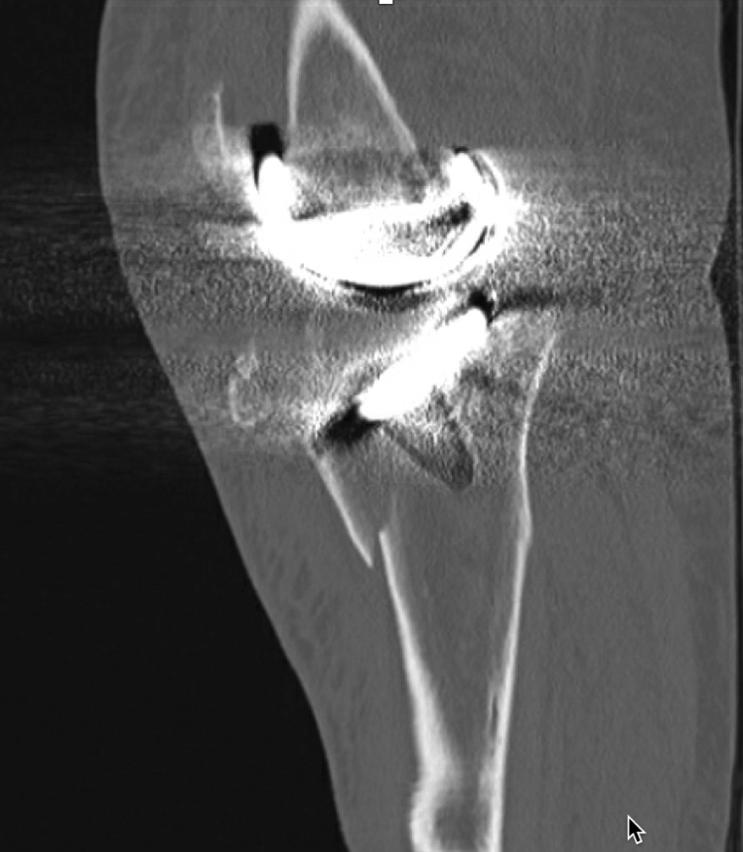
First, there was radiographic evidence of insufficient collaterals due to the displacement of the tibial baseplate and proximal tibia from the tibial shaft. Second, both the history and CT scan supported a loose tibial component, excluding the possibility of an isolated open reduction and internal fixation of this periprosthetic fracture. Third, there was a large tibial tubercle fracture fragment which required thoughtful plans for fixation and/or reconstruction of the extensor mechanism. Fourth, the comminution and poor bone tibial bone stock seen on X-ray required multiple prosthetic options to reconstruct the joint line. Thus, the massive bone loss with insufficient collaterals necessitated revision to a hinged TKA component with multiple options for tibial reconstruction.
A condylar resurfacing hinge was selected with multiple tibial reconstruction options. The primary tibial plan was to stack tibial cones and to fix the tibial tubercle with multiple screws or by burring fixation holes into the cone with a metal-cutting burr. Alternatively, the tubercle could be fixed through the manufactured holes of a proximal tibial segmental sleeve. Finally, if the tubercle could not be fixed due to comminution, Marlex mesh was on backup for reconstruction of the extensor mechanism.

At surgery, the tibial tray was grossly loose and the tibial tubercle was fractured in the coronal plane similar to a tibial tubercle osteotomy, which aided in exposure (Figure 3). The femoral component was well-fixed, but the tibial tray was grossly loose and pulled out by hand. The collateral ligaments were found to be ruptured, and the femur was removed with minimal bone loss. The remaining tibia was an eggshell cylinder of bone with a portion that the tibial tubercle could key into it. We had two reconstruction options at this point: resect the eggshell bone and perform a proximal tibial replacement or augment this bone with a cone and reduce the fractured tubercle to it.
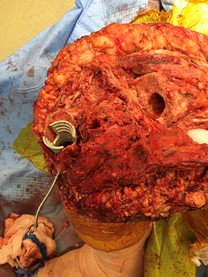
To follow bone-preserving principles, it was decided to try to keep this remnant of proximal tibial shaft intact. A Luque wire was prophylactically placed under direct visualization distal to the fracture site to prevent fracture propagation during insertion of a cone (Figure 4). Various sizes of tibial non-modular components and sleeves were trialed until the joint line was re-created. A 5-cm proximal tibial sleeve was chosen and unitized to a 160-mm non-modular long tibial baseplate. The femur was then reamed and cut to accept a 3-cm resurfacing femoral component with a 150-mm stem being careful to externally rotate the implant to allow for proper patellar tracking. The appropriate poly insert was selected, and the hinge assembled (Figure 5).
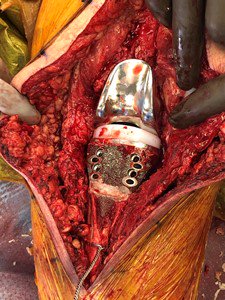
We then turned our attention to the tibial tubercle. Two 16-gauge stainless steel sternal wires were passed through drill holes in the remnant of the tibia shaft around the tubercle and tightened with a needle driver. The fixation was reinforced with #5 FiberWire through the suture holes of the proximal tibial sleeve. This reduced the tibial tubercle to its anatomic location on the tibia directly anterior to the cone (Figures 6 and 7). Due to high risk of infection, the wound was irrigated with dilute betadine, hydrogen peroxide and 3L NS followed by 1 gram of vancomycin powder. An incisional negative pressure wound dressing was placed on the incision to help with wound healing.
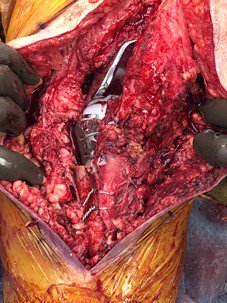
Postoperatively, the patient received 24 hours of standard IV antibiotics followed by 1 month of PO Keflex 500 mg three times a day. She was made touch-down weight-bearing locked in extension for 3 months.
Discussion
Periprosthetic tibia fractures following total knee arthroplasty are rare but devastating complications. The most widely used classification system to guide treatment for these proximal tibia fractures is the Felix classification.
Type I fractures extend partially across the tibial plateau. Type II extend across the tibial metaphyseal-diaphyseal region adjacent to the tibial stem. Type III occur distal to the stem. Type IV involve the tibial tubercle. These four types are then further categorized by a stem that is well-fixed, loose or intraoperative. Treatment depends largely on Felix type, component fixation and timing of the fracture.
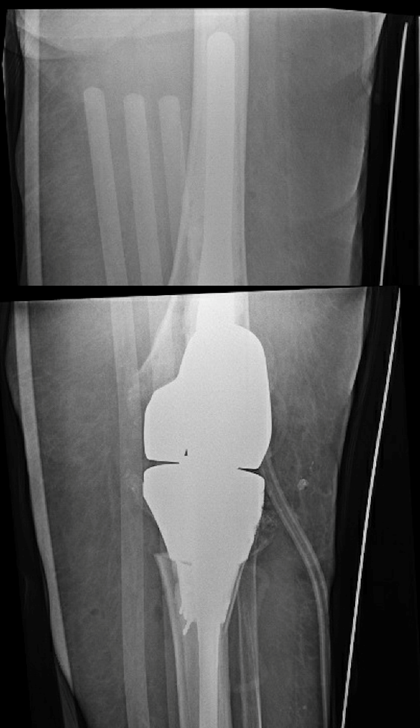
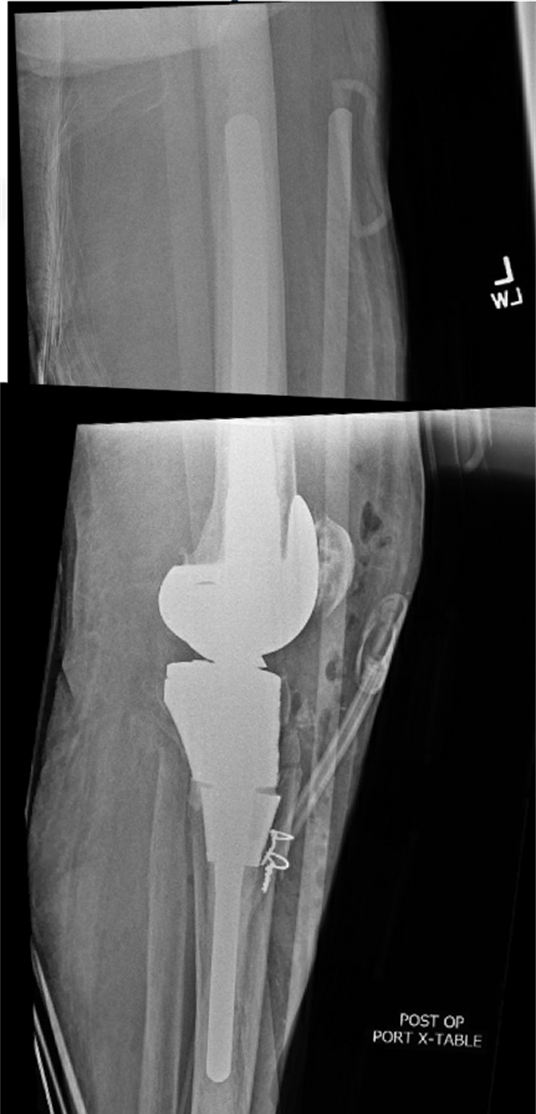
Open reduction and internal fixation is indicated for displaced fractures with stable components, but nonunion and reoperation rates remain high even with modern plating techniques. Revision arthroplasty is indicated for fractures with a loose tibia or comminution beyond salvage with fixation. Regardless of treatment type or Felix fracture type, periprosthetic tibia fractures are associated with high complication and revision rates. In a review of 34 consecutive periprosthetic tibia fractures, Pannu and colleagues assessed clinical outcomes based on the Felix classification and treatment type. They found all fractures, regardless of Felix type, had more than a 30% revision rate and more than a 50% readmission rate, with infection being the most common complication. When comparing treatment types, they found proximal tibial replacements had significantly higher rates of postoperative infections, revision surgeries and subsequent flap surgeries compared with other treatment options.
In the current case, the periprosthetic tibia fracture was unique in that it was combined with a loose tibial tray, ruptured collaterals and massive tibial bone loss. Therefore, fixation of the fracture was not an option. Due to the massive bone loss and insufficient collaterals, a hinged TKA was indicated. Historically, hinged TKAs or mega prostheses for fracture have had high revision rates, with infection being the leading cause for nonmechanical complications. In the current case requiring a mega prosthesis for reconstruction, this diabetic patient was at high risk for infection and treated as if she had a PJI: joint irrigation protocol, incisional wound vac and extended PO antibiotics.
Take-home message
Periprosthetic tibia fractures are complex injuries that have high complication rates. Treatment for such injuries depends largely on the location of the fracture, component fixation and timing of the fracture. In-depth preoperative planning must take place and a wide variety of implants must be available for intraoperative adjustments to the reconstruction plan. In this case of a comminuted periprosthetic tibia fracture with ruptured collaterals around a loose tibial tray, revision to a long-stem hinged prosthesis was used as a solution to a complex problem.
References:
Felix NA, et al. Clin Orthop Relat Res. 1997(345):113-124.
Morwood MP, et al. Injury. 2019;doi: 10.1016/j.injury.2019.03.014.
Pannu TS, et al. J Arthroplasty. 2021; doi: 10.1016/j.arth.2020.10.035.
Windhager R, et al. Int Orthop. 2016;doi:10.1007/s00264-015-2991-4.
